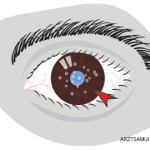NEW YORK (Reuters Health)—Adalimumab reduces the risk of uveitic flare after corticosteroid withdrawal in patients with inactive, noninfectious uveitis, according to results from VISUAL II.
“Tumor-necrosis factor (TNF) inhibition, which has been demonstrated to have strong efficacy in rheumatologic disorders, can also have significant role in the management of noninfectious uveitis, even amidst the challenges of heterogeneity of uveitic entities,” Dr. Quan Dong Nguyen from University of Nebraska Medical Center in Omaha tells Reuters Health by email.
Corticosteroids are the mainstay of uveitis treatment, but ocular and systemic side effects restrict their long-term use. The VISUAL I clinical trial and other prospective studies have found anti-TNF drugs, including adalimumab, to be safe and effective for treating uveitis and reducing corticosteroid use.
In a randomized, controlled trial of 229 patients, Dr. Nguyen and colleagues from 62 study sites in 21 countries tested adalimumab for preventing reactivation of noninfectious uveitis controlled by corticosteroids.
The median follow-up was 155 days in the placebo group and 245 days in the adalimumab group. The treatment failure rate was 55% in the placebo group and 39% in the adalimumab group, a significant 43% reduction with adalimumab.
The median time to treatment failure was 8.3 months with placebo, compared with >18 months (median not reached) with adalimumab, according to the Aug. 16 online report in The Lancet.
Most of the measurable effect of adalimumab was on the best-corrected visual acuity component of the time to treatment failure primary efficacy endpoint, the researchers note.
Rates of adverse and serious adverse events were similar in the two groups.
“The safety of TNF inhibitors, such as that of infliximab and adalimumab, has been observed and relatively accepted during the past decade,” Dr. Nguyen says. “Studies of adalimumab in uveitis have not revealed or demonstrated any new or additional concerns, thus allowing clinician scientists (ophthalmologists in this setting) to evaluate fully the risks and benefits of adalimumab for patients with uveitis.”
“When there is a uveitic flare, unless it is contraindicated, many uveitis specialists will consider adding or increasing the dose of corticosteroids,” Dr. Nguyen says. “At such time, one can also initiate adalimumab, knowing that with the presence of adalimumab, steroids can be tapered with well-proven confidence that treatment failure with recurrence of disease and flare is very unlikely to occur.”
Alastair K. Denniston from University Hospitals Birmingham NHS Foundation Trust in the UK, who coauthored an editorial related to this report, tells Reuters Health by email, “We recognize that uveitis is a heterogeneous disease which may cause variable inflammatory sequelae within the eye, and it is perfectly possible that immunosuppressants may show differential benefit in tackling particular aspects of the disease. Future studies of the scale and quality of the VISUAL studies are urgently needed in uveitis to establish the relative merits of the commonly used therapeutics for the range of uveitic presentations, and to help establish where each agent should fit into the treatment pathway.”


